Alexander Hamilton in NYC: A Legacy and History Tour
He’s the man on the $10 bill whose life story is now the hit Broadway musical Hamilton. And for more than 30 years, Alexander Hamilton was also a New York City resident. Within our city's parks, you can discover Hamilton's life and legacy.
My Name is Alexander Hamilton*
Alexander Hamilton is the only person (besides Benjamin Franklin) on a U.S. bill who wasn’t a president. In fact, Hamilton was a leading figure in creating the United States’ financial system—he helped establish the U.S. dollar, the U.S. Mint, and the nation’s first national bank. He’s also one of the United States' founding fathers and the country's first U.S. Secretary of Treasury.
The Move to the Greatest City in the World
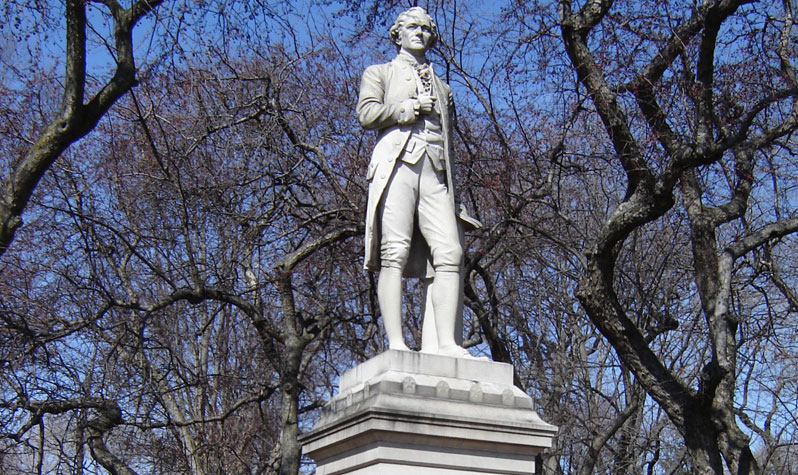
A statue of Hamilton stands in Central Park today, along the East Drive at 83rd Street. More information about the monument
Hamilton wasn’t born in the United States. He was born in the West Indies on the island of Nevis in either 1755 or 1757 (the exact year of his birth has not been confirmed). From meager beginnings and life as an orphan, he moved to New York City in 1772 and attended King’s College (now Columbia University) on a scholarship.
Hamilton Becomes Washington’s Right Hand Man
While Hamilton was in college, the Revolutionary War started and King's College shuttered. Hamilton joined in a New York artillery company. He became a captain of the 1st Battalion, 5th Field Artillery Regiment (the oldest existing unit in the U.S. Army and the only one remaining from the Revolution) and was so good at his job that he later became George Washington’s aide and secretary.

This gilded lead statue of King George III was erected in Bowling Green Park in 1770. Photo courtesy of NYC Parks Arts & Antiquities
He was there in "the Fields", now City Hall Park, when the Declaration of Independence was read for the first time on July 9, 1776. A mob rushed to Bowling Green Park and toppled the statue of King George III. They hacked it to pieces and recast it as musket balls—the war wasn't over yet.

The Old Stone House is a replica of a Dutch stone farmhouse that was built in 1699.
Following the United States Independence, the Battle of Brooklyn (the largest battle in the Revolutionary War) was fought on the ground that later became Prospect Park. At what is now Washington Park, British and Hessian soldiers used the Old Stone House as an artillery position to successfully attack the Maryland Brigade.

Fort Washington Park is one of many Northern Manhattan Parks that share the rich history of the Revolutionary War. (Photo by Daniel Avila)
Even more battles followed in North Manhattan at Fort Tryon Park, Inwood Hill Park, Bennett Park, Fort Washington Park, Fort Tryon Park, and St. Nicholas Park.
In 1780, Hamilton married Elizabeth Schuyler and left the army in 1781.
What Comes Next? Non-Stop Hamilton
- 1782: Hamilton was admitted to the bar. He began a law practice in New York, and became a delegate in the Continental Congress.
- 1784: He established the Bank of New York (the oldest ongoing bank in the United States).
- 1787: He attended the Constitutional Convention in Philadelphia and helped develop our current federal constitution and justified its ratification with the Federalist Papers—85 articles of which Hamilton wrote 51, all within six months.
- 1789: Hamilton co-founded the Federalist Party (the first American political party) and became the first U.S. Secretary of Treasury under the country’s first president, George Washington.
- 1790: The creation of the Revenue-Marine/Revenue Cutter Service an armed customs enforcement service was recommended by Hamilton. It later became the U.S. Coast Guard.
- 1791: Hamilton helped established the country’s first national bank.
- 1792: Hamilton helped to create the Coinage Act which established the U.S. Mint and the U.S. dollar.
It’s Quiet Uptown
When Hamilton retired from the government, he settled down quietly in what became Hamilton Heights in modern-day Harlem. He built a house—a country estate called The Grange at 141st Street. It was completed in 1802 and was the only home Hamilton ever owned.
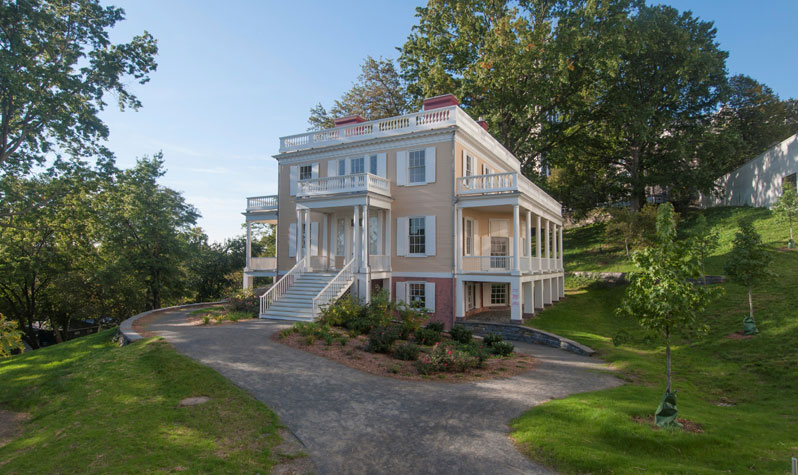
The Hamilton Grange National Memorial is located in St. Nicholas Park. (Photo credit: National Parks Service)
Hamilton loved attending Archibald Gracie's elegant affairs at the Gracie Mansion in Carl Schurz Park, now the official residence of NYC's mayor. He was so inspired by the mansion's architecture that he recruited the same builder and architect to create the Hamilton Grange.
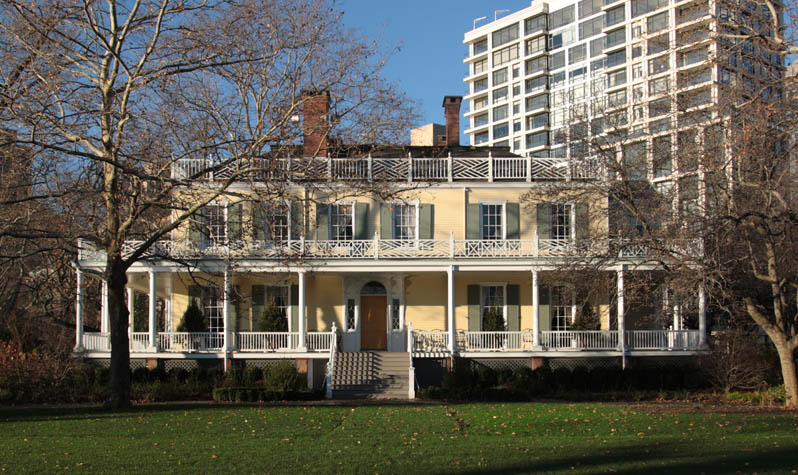
Gracie Mansion in Carl Schurz Park. (Photo courtesy of Gracie Mansion)
Gracie and Hamilton were close pals who shared the same social and political circles and business ventures—Gracie was also an ally to the Federalist Party and Hamilton was Gracie's business advisor. It was here, at Gracie Mansion, where Hamilton in 1801 raised funds to found the New-York Evening Post, now the New York Post—the oldest continuously published daily newspaper in the United States. Years later, in 1966, the fireplace mantle where Hamilton died in front of, was moved to Gracie Mansion as a centerpiece of the Susan B. Wagner Room where the mayor holds press conferences and social gatherings.
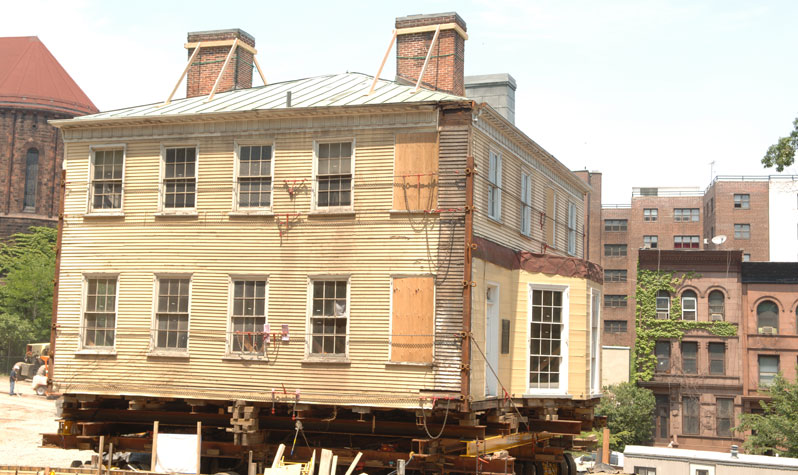
Our photographer Malcolm Pinckney documented the historic move of Hamilton's house to St. Nicholas Park.
In 2006, Hamilton's home was moved a few blocks to the north end of St. Nicholas Park at 141st Street near Hamilton Terrace. Today, Hamilton Grange National Memorial is operated by the National Park Service, and is dedicated to telling the story of Hamilton and his home. More information about The Grange
In honor of his legacy and residency in the neighborhood, a playground nearby at Hamilton Place and 141st Street was named in his honor. Other parks named for Hamilton include Hamilton Metz Field in Brooklyn and the Federalist Triangle in Queens.

The Hamilton Fountain over at Riverside Park is named for Alexander Hamilton's great-grandson, Robert Ray Hamilton (1851-1890). The fountain is one of the finest and last surviving examples of the city's decorative horse troughs, which were popular during its era when horses were the primary means of transportation. Robert Ray Hamilton died in a hunting incident in 1890.
Wait For It...
It’s impossible to tell Hamilton’s story without mentioning his greatest "frenemy," Aaron Burr.
Hamilton was younger than 50 years old when he died in a tragic duel with Burr, who was then the Vice President of the United States.
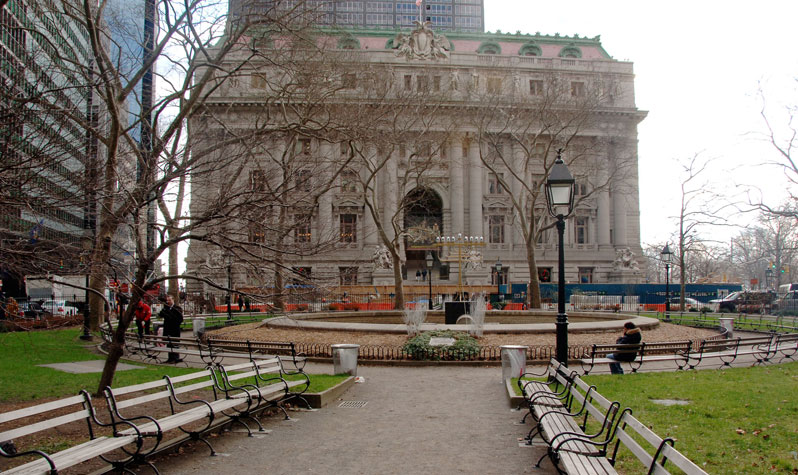
The Alexander Hamilton U.S. Custom House is located at the south end of Bowling Green Park(Photo by Daniel Avila/NYC Parks)
Both Hamilton and his wife Elizabeth were interred at Trinity Church, located just two blocks north of Bowling Green. At the other end of Bowling Green, you can find the Alexander Hamilton U.S. Custom House. This majestic 1907 Beaux Arts building was designed by Cass Gilbert and was declared a National Historic Landmark in 1976, and named for the father of the Treasury in 1990.
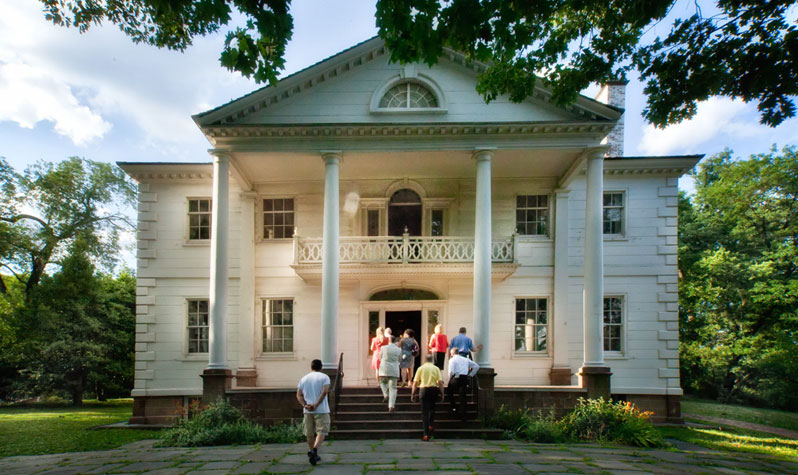
The Morris-Jumel Mansion Museum is the oldest house in Manhattan. It was built in 1765.
Aaron Burr later married a colorful socialite named Eliza Jumel, who was the owner of the Morris-Jumel Mansion at Roger Morris Park. When Eliza decided to divorce Burr, she used Alexander Hamilton’s son as a divorce attorney. Aaron Burr died on the same day the divorce was finalized.
The Room Where It Happened
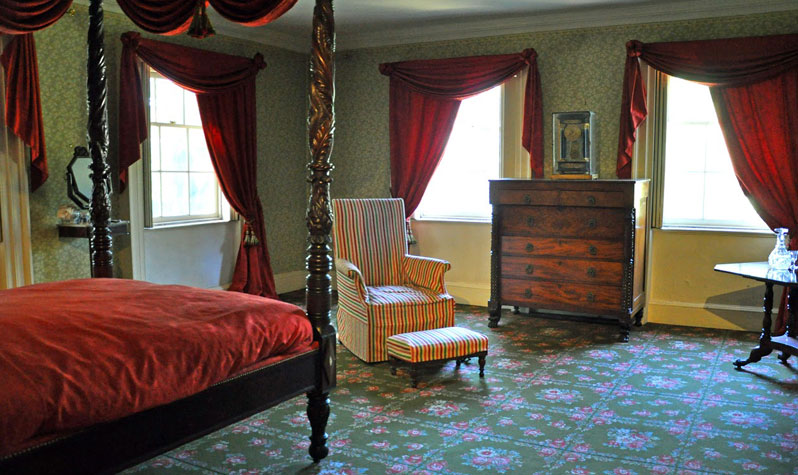
Photo by Trish Mayo/Morris-Jumel Mansion
It’s no wonder when Lin-Manuel Miranda sought inspiration for Hamilton the musical, he did so by writing portions of it at the Morris-Jumel Mansion. Miranda wrote the songs "Wait For it" and "The Room Where It Happens" in Aaron Burr's bedroom at the Morris-Jumel Mansion.
The Morris-Jumel Mansion, Old Stone House, and Gracie Mansion are members of the Historic House Trust.
*Writer’s note: The headlines are an ode to musical numbers from the Broadway musical Hamilton.